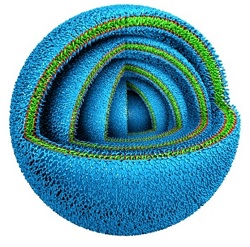 |
| "Onion" dendrimersome--Courtesy of UPenn |
A new type of drug delivery vehicle from the University of Pennsylvania is made up of several membranes layered upon each other to protect the drug at its core or possibly deliver a few different drugs over time.
With a structure based on models from nature, including myelin sheaths and the concentric layout of onions, the scientists created vesicles with as many as 20 layers, consistently spaced. The consistency is important to maintain the size of the vesicles and to ultimately load them with drugs for a predictable timed release.
They accomplished the design via two-faced membranes comprising amphiphilic Janus dendrimers, which have layers themselves to ensure protection of the drugs carried inside, according to a report from UPenn.
The team published the study in the journal Proceedings of the National Academy of Sciences.
It has been difficult up until now to produce such vesicles on a practical level.
 |
| Virgil Percec |
"The only way it has been achieved in the past was through a complicated mechanical process, which was a dead end," lead author Virgil Percec said in a statement. "This was not a viable option for mass-producing multilayered vesicles, but, with our library of amphiphilic Janus dendrimers, we were lucky to find some molecules that have in their chemicals instructions needed to self-assemble into these very beautiful structures."
And their delivery potential lies in their stability in the bloodstream.
"If you want to deliver a single drug over the course of 20 days," Percec said, "you could think about putting one dose of the drug in each layer and have it released over time. Or you might put one drug in the first layer, another drug in the second and so on. Being able to control the diameter of the vesicles may also have clinical uses; target cells might only accept vesicles of a certain size."
- here's the UPenn report
- and here's the abstract